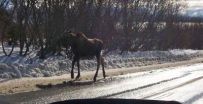(Press-News.org) This release is available in French.
Montreal, May 17, 2010 – Country roadways can be hazardous for moose and men. According to estimates, millions of vehicles collide with moose, elk and caribou in North America and Europe each year. Moose, in particular, venture to roadsides to lick the salt pools that collect following pavement deicing.
Because moose are the largest animal in the deer family, with males weighing up to 720 kilograms, their salt cravings can pose significant risks to human and vehicle safety. That's why a group of Canadian researchers has investigated ways to encourage moose away from roads.
In a new study, published in the journal Ecological Modelling, lead author Paul D. Grosman reports how the large mammals can adeptly recall the salt pools they visit in previous years. "When the scheduled time came to go to a salt pool, moose moved directly to it with purpose," says Grosman, a graduate student in the Concordia University Department of Geography, Planning and Environment. "Sodium concentration is two or three times higher in roadside salt pools compared to aquatic plants, yet those salt pools increase the probability of moose-vehicle collisions by 80 percent."
To avoid moose-man collisions, the best scenario is to completely remove roadside salt pools, Grosman stresses: "If compensation salt pools are used, they should be located as far as possible from the roads – beyond 500 meters."
Grosman conducted his investigation with Concordia professors Jochen A.G. Jaeger and Pascale M. Biron, as well as colleagues from the Université du Québec à Rimouski and the Ministère des Ressources naturelles et de la Faune du Québec (Quebec Ministry of Natural Resources and Wildlife). The research team focused on a portion of the Laurentides Wildlife Reserve, situated between Quebec City and Saguenay, which features two provincial highways crossing its territory.
Some 47 tagged moose were monitored for three years via global positioning system as they travelled, rested and foraged. A computer-animated control group of 40 moose served as a point of comparison.
The research team tested various scenarios, such as removing salt pools altogether or creating compensation salt pools. Although moose could travel as much as 10 kilometers to drink from salt pools, their road crossings could be reduced by as much as 79 per cent when all road-side salt pools were removed.
"The most effective management strategy is to remove all salt pools, without creating any compensatory ones, and let moose return to foraging for aquatic plants to satisfy their sodium dietary requirement," says Grosman, noting that other costlier security measures include fencing highways or building wildlife underpasses.
INFORMATION:
From May 24 to May 27, 2011, Jaeger and Grosman will take part in a French language conference on large and small fauna, in Quebec City: "Routes et faune terrestre: De la science aux solutions." For more information, please consult the conference website at www.uqar.ca/routes-faune-terrestre.
Partners in research:
This study was funded by the Ministère des Transports du Québec, the Ministère des Ressources naturelles et de la Faune du Québec, the Université du Québec à Rimouski, the Fonds québécois de la recherche sur la nature et les technologies, Natural Sciences and Engineering Research Council and the J.W. McConnell Graduate Memorial Fellowship.
About the study:
The paper, Trade-off between road avoidance and attraction by roadside salt pools in moose: An agent-based model to assess measures for reducing moose-vehicle collisions," published in the journal Ecological Modelling, was coauthored by Paul D. Grosman, Jochen A.G. Jaeger and Pascale M. Biron of Concordia University, Christian Dussault of the Ministère des Ressources naturelles et de la Faune du Québec and Jean-Pierre Ouellet of the Université du Québec à Rimouski.
Related links:
Cited research: http://bit.ly/lSumfc
Concordia Department of Geography, Planning and Environment: http://gpe.concordia.ca
Ministère des Ressources naturelles et de la Faune du Québec: www.mrnf.gouv.qc.ca
Université du Québec à Rimouski : www.uqar.ca
Source:
Sylvain-Jacques Desjardins
Senior advisor, external communications
Concordia University
Phone: 514-848-2424, ext. 5068
Email: s-j.desjardins@concordia.ca
Twitter: http://twitter.com/concordianews
Concordia news: http://now.concordia.ca
Of moose and men
Study finds removal of roadside salt pools can protect salt-toothed moose from crossing roads
2011-05-18
ELSE PRESS RELEASES FROM THIS DATE:
Pets Best Insurance Invites Facebook Friends to "Ask a Vet" Their Pet Health Questions
2011-05-18
Pets Best Insurance believes that knowledge is power--especially when it comes to our pets' health care. While the pet insurance company always recommends taking a pet in for veterinary evaluation at the first sign of illness, it has also created a means for pet owners to ask a licensed veterinarian general pet health and behavioral questions on its Facebook page.
Dr. Fiona Caldwell, of Idaho Veterinary Hospital in Nampa, Idaho responds to the questions on film each week. The clips are then posted to the Pets Best Insurance Facebook wall, http://www.facebook.com/PetsBestInsurance ...
Forest Service unveils first comprehensive forecast on southern forests
2011-05-18
The USDA Forest Service and the Southern Group of State Foresters released the first phase of the Southern Forest Futures Project report on Tuesday, May 17, which identifies areas forest managers will focus on to maintain southern forests in the coming years.
According to the report, urbanization, bioenergy use, weather patterns, land ownership changes and invasive species will significantly alter the South's forests between the years 2010 and 2060. About 23 million acres of forest land are projected to decrease. People are also expected to influence water resources, ...
Staff-prisoner relationships are key to prison quality
2011-05-18
As public sector prisons move towards the thin staffing level model of profit-making institutions, with their high turnover of personnel who are less connected to their occupation, a study funded by the Economic and Social Research Council (ESRC) warns of a potentially detrimental impact on prison quality.
"Until now, little has been known about the relative strengths and weaknesses of public and private prisons," says Professor Liebling of Cambridge University who led the research. "Today, when the privatisation of prisons is on the increase and the public sector staffing ...
Understanding a bacterial immune system 1 step at a time
2011-05-18
Researchers at the University of Alberta have taken an important step in understanding an immune system of bacteria, a finding that could have implications for medical care and both the pharmaceutical and dairy industries.
In research published in the high impact journal Nature Structural & Molecular Biology, Andrew MacMillan and co-workers in his lab have described the first step of the immune response of bacterial cells. Scientists had previously found that a bacterial virus, called a bacteriophage, attacks a bacterial cell by injecting its DNA in to the cell. MacMillan's ...
Pro athletes ought to bargain outside federal court, legal scholar says
2011-05-18
CHAMPAIGN, Ill. — New research by a University of Illinois law and labor expert shows that in labor disputes between professional athletes and owners, courts have consistently failed to maintain a clear separation between antitrust and labor law.
While players in the three major sports – football, baseball and basketball – have pursued a two-pronged approach of collective bargaining and antitrust litigation to eliminate owner-imposed constraints on labor market competition, Michael LeRoy says that the institution of collective bargaining should not be subordinated to ...
Madison, WI Event Aims to Pass the $1 Million Mark in Funds Raised for Local Charities
2011-05-18
Madisonians can all agree they are anxiously waiting for the first smells of summer and the moment they can fire up the grill. The good news is, they don't have to wait long! This year's biggest summer grilling kickoff will be at The World's Largest Brat Fest, now in its 29th year of record-breaking grilling!
The 2011 World's Largest Brat Fest, sponsored by Johnsonville Sausage and produced by Metcalfe's Market, will be held rain or shine Memorial Day Weekend, May 27 through the 30 in Madison, WI.
"This is the time of year we absolutely love; it's the time when ...
True love may wait -- but waiting won't make you a safer lover later on
2011-05-18
Whether sex education focuses only on abstinence or teaches students about contraception and other topics as well, it all shares one main message: Wait. In abstinence-only, students are exhorted to wait for sex until they're married. In "comprehensive" or "abstinence-plus," the idea is to delay sexual relations until . . . later.
"The underlying assumption is that delay reduces sexual risk-taking"—and with it unwanted pregnancies and sexually transmitted diseases, says University of South Florida psychologist Marina A. Bornovalova. "If they just wait, then they'll be ...
Most common form of inherited intellectual disability may be treatable
2011-05-18
Advancements over the last 10 years in understanding intellectual disability (ID, formerly mental retardation), have led to the once-unimaginable possibility that ID may be treatable, a review of more than 100 studies on the topic has concluded. It appears in ACS Chemical Neuroscience.
Aileen Healy and colleagues explain that people long have viewed intellectual disability as permanent and untreatable, with medical care focusing on relieving some of the symptoms rather than correcting the underlying causes. That includes Fragile X syndrome (FXS), the most common inherited ...
New method of unreeling cocoons could extend silk industry beyond Asia
2011-05-18
The development and successful testing of a method for unreeling the strands of silk in wild silkworm cocoons could clear the way for establishment of new silk industries not only in Asia but also in vast areas of Africa and South America. The report appears in ACS' journal Biomacromolecules.
Fritz Vollrath, Tom Gheysens and colleagues explain that silk is made by unraveling— or unreeling — the fine, soft thread from cocoons of silkmoths. The practice began as far back as 3500 BC in ancient China, where silk was the fabric of royalty. Today, most silk comes from cocoons ...
Safety concerns about adulterated drug ingredients
2011-05-18
Government regulators and pharmaceutical companies are moving to address a major new risk for the global supply of medicines: The possibility that unsafe ingredients are entering the supply chain as pharmaceutical companies increasingly outsource the production of drug ingredients to third parties. That's the topic of the cover story in the current edition of Chemical & Engineering News (C&EN), ACS' weekly newsmagazine.
C&EN Senior Editor Rick Mullin explains that the jolt for action came from several incidents. One incident —a major 2008 recall of contaminated heparin ...
LAST 30 PRESS RELEASES:
Science briefing: An update on GLP-1 drugs for obesity
Lower doses of immunotherapy for skin cancer give better results
Why didn’t the senior citizen cross the road? Slower crossings may help people with reduced mobility
ASH 2025: Study suggests that a virtual program focusing on diet and exercise can help reduce side effects of lymphoma treatment
A sound defense: Noisy pupae puff away potential predators
Azacitidine–venetoclax combination outperforms standard care in acute myeloid leukemia patients eligible for intensive chemotherapy
Adding epcoritamab to standard second-line therapy improves follicular lymphoma outcomes
New findings support a chemo-free approach for treating Ph+ ALL
Non-covalent btki pirtobrutinib shows promise as frontline therapy for CLL/SLL
University of Cincinnati experts present research at annual hematology event
ASH 2025: Antibody therapy eradicates traces of multiple myeloma in preliminary trial
ASH 2025: AI uncovers how DNA architecture failures trigger blood cancer
ASH 2025: New study shows that patients can safely receive stem cell transplants from mismatched, unrelated donors
Protective regimen allows successful stem cell transplant even without close genetic match between donor and recipient
Continuous and fixed-duration treatments result in similar outcomes for CLL
Measurable residual disease shows strong potential as an early indicator of survival in patients with acute myeloid leukemia
Chemotherapy and radiation are comparable as pre-transplant conditioning for patients with b-acute lymphoblastic leukemia who have no measurable residual disease
Roughly one-third of families with children being treated for leukemia struggle to pay living expenses
Quality improvement project results in increased screening and treatment for iron deficiency in pregnancy
IV iron improves survival, increases hemoglobin in hospitalized patients with iron-deficiency anemia and an acute infection
Black patients with acute myeloid leukemia are younger at diagnosis and experience poorer survival outcomes than White patients
Emergency departments fall short on delivering timely treatment for sickle cell pain
Study shows no clear evidence of harm from hydroxyurea use during pregnancy
Long-term outlook is positive for most after hematopoietic cell transplant for sickle cell disease
Study offers real-world data on commercial implementation of gene therapies for sickle cell disease and beta thalassemia
Early results suggest exa-cel gene therapy works well in children
NTIDE: Disability employment holds steady after data hiatus
Social lives of viruses affect antiviral resistance
Dose of psilocybin, dash of rabies point to treatment for depression
Helping health care providers navigate social, political, and legal barriers to patient care
[Press-News.org] Of moose and menStudy finds removal of roadside salt pools can protect salt-toothed moose from crossing roads



